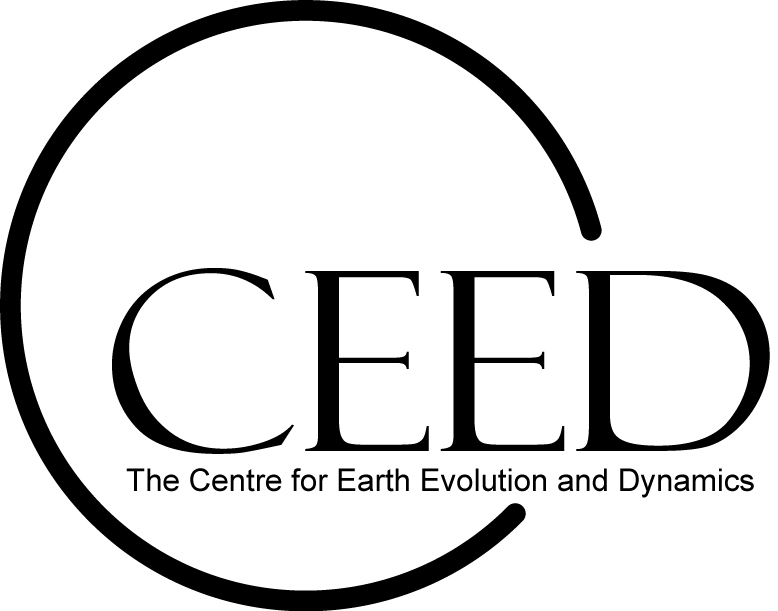|
Water Planet An Umbrella Project at the Centre for Earth Evolution and Dynamics |

|
Research Topics: Mantle Dynamics | Volcanism | Surface Deformation | Seafloor Geology | Planets |
Water and Volcanism
|
Water is a key ingredient of volcanism; it plays a major role in the
formation of many volcanoes, it affects both the viscosity of magmas
and the explosiveness eruptions. The volcanic arc chains at
convergent margins (Fig. 1), such as the volcanoes of the “ring of
fire” around the Pacific Ocean, form thanks to the water released
from the subducting plate at depth. Away from subduction zones,
magmas produced at the mid-ocean ridges and in intraplate settings
can also release small amounts of water transported from the deep
mantle. All of these volcanic systems can interact with water near
the Earth’s surface, producing hydrothermal or hybrid systems, or
eruptions associated with glacial unloading. As a result, water is
intimately linked to volcanism throughout the earth system, from the
deep mantle to the surface, across timescales as short as those
relevant for climate change and as long those associated with
earth’s geologic history.
Arc Volcanism Volcanic arcs are the result of slab dehydration during subduction. When hydrous minerals in the slab break down at depth, their water is released into the mantle wedge, which triggers mantle melting. This melt then rises to the overriding plate, generating the volcanic arc. The combination of mechanisms for fluid generation and melt migration, as well as the pressure-temperature conditions along the melt’s path through the wedge, affect the position of the arc, the amount of melt production, and the composition of the newly generated crust. Moreover, some of the fluids sourced from the subducting plate are released at shallow depths (<50 km) - this hydrates the forearc by serpentinization and, in some cases, generates serpentine mud volcanism. In some scenarios, slab fluids are also involved in melt production at the back-arc during the generation of new oceanic crust. Study of these processes is crucial for understanding present and past rock records at convergent margins, and for using the rock record to improve plate tectonic reconstruction models.
Intraplate and Mid-Ocean Ridge Volcanism Most of the volcanism that occurs away from the subduction zones can be found submerged beneath the oceans, and therefore our knowledge of this volcanism is largely based on study of marine geology (Water & Seafloor Geology). Most of this non-arc volcanism is generated by decompression melting associated with some sort of upwelling in the uppermost mantle. This upwelling can be a passive response to tectonic spreading (at mid-ocean ridges), the result of heat rising from the deep mantle (plumes), a consequence of sublithospheric or asthenospheric dynamics (small-scale convection, edge-driven convection or shear-driven upwelling), or caused by extensional stresses in the lithosphere (petit-spots). While some of this volcanism is relatively minor (e.g., seamounts and petit-spots), it can be extensive (flood-basalts and seafloor spreading). Because hydrated minerals tend to melt at colder temperatures, water in the mantle is intimately linked to non-arc volcanism, and indeed is an important and poorly-understood part of the water cycle within Earth’s interior (Water & Mantle Dynamics). Finally, the decompression melting that forms the basis for intraplate and mid-ocean ridge volcanism can be affected by changes to the loads of water stored on the Earth’s surface. In particular, volcanism in polar regions (e.g., Iceland) can be enhanced by subsurface decompression associated with deglaciation (Water & Surface Deformation). Similarly, submarine volcanism at seamounts and mid-ocean ridges may be affected by changes to surface loading associated with sea level change. Although these links are poorly understood, they highlight the possibility of important water-related interactions between volcanism and climate change.
Hydrothermal Systems Hydrothermal systems are generated by a set of processes that involve the circulation of hot aqueous fluids at depth. These systems are characterized by an intricate subsurface network that provides pathways for migration of hot fluids. Often hydrothermal systems manifest at the surface with spectacular phenomena such as geysers and hot water springs that result from a mixture of deeply-sourced hot fluids and shallow (often meteoric) waters. These systems are typically associated with volcanic activity or may be related to intrusive bodies migrating from magma chambers seated at depth. Hydrothermal systems are characterized by elevated geothermal gradients and are typically CO2 dominated. The chemistry of the rising fluids (i.e. water and gas) provides important insights into the reactions occurring at depth. Oceanic transform plate boundaries also represent pathways for hydrothermal circulation. Here, faulting is combined with serpentinization-driven expansion of uplifted mantle rocks to provide open pathways for hydrothermal circulation and associated water-rock interactions. Serpentinization produces high concentrations of CH4 and H2 in the fluids that provide energy for chemosynthetic biota.
Hybrid Systems Sediment-Hosted Hydrothermal Systems (SHHSs) are hybrid geological systems where volcanic and sedimentary domains interact, leading to mixtures of inorganic and organic gases. SHHSs are typically characterized by geothermal (thermometamorphic or mantle-derived) CO2 and biotic (microbial or thermogenic) CH4, and occur in sedimentary basins affected by magmatic intrusions or involved in volcanic plumbing systems. These hybrid systems can be of considerable interest for petroleum exploration and natural greenhouse-gas emission studies. SHHSs can lead to host source rocks with enhanced thermal maturity. In certain cases, it is possible that the development of hydrocarbons in the sedimentary rocks is facilitated by anomalous thermal regimes.SHHSs are also common as palaeo-hydrothermal vent systems, in the large igneous provinces (LIPs) emplaced within large sedimentary basins e.g. in South Africa, Russia, and the North Atlantic. Similarly to the modern SHHS, the palaeo systems can have peculiar implications for petroleum exploration and global climate change studies. SHHSs, in fact, (1) may lead to production of hydrocarbons resulting from enhanced thermal maturity of sedimentary source rocks; (2) can be significant natural sources of greenhouse gas (CO2 and CH4) emissions to the atmosphere, and (3) are potential drivers of past climate changes.
|

|
 |

